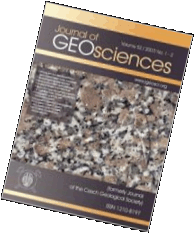 Export to Mendeley
Export to MendeleyOriginal paper
Exploring metamorphic temperatures in the Kaczawa Metamorphic Complex using Raman spectroscopy of carbonaceous material
Journal of Geosciences, volume 70 (2025), issue 1, 1 - 14
DOI: http://doi.org/10.3190/jgeosci.401
Raman spectroscopy was used to measure the thermal maturity of organic matter in widespread low-grade Ordovician and Silurian metasedimentary rocks of the Kaczawa Metamorphic Complex. The suitability of different Raman-based geothermometer formulations for estimating peak metamorphic temperatures in the studied rocks was evaluated. Among the tested geothermometers, the formulation based on the full width at half maximum of the D1 band, and the calculations performed with the IFORS software yielded most consistent results, reproducing with sufficient accuracy and reliability the peak metamorphic temperatures obtained by other authors. Disruptions in the regional temperature distributions due to thermal overprint caused by local volcanic activity were identified by studying the contact aureole around a large body of the Wielisławka Rhyolite. It was found that the influence of contact metamorphism on the measured spectral parameters becomes insignificant at about 150 m away from the contact. The regional distribution of peak temperatures not affected by late thermal overprinting shows a clear pattern with the record of higher temperatures preserved in the southern part of the Kaczawa Metamorphic Complex. Depending on the tectonic unit, peak temperatures vary from 312 to 352 °C, with an average of about 331 °C. Temperatures calculated for the units in the northern Kaczawa Metamorphic Complex branch range from 278 to 301 °C, with an average of 289 °C. With estimated geothermal gradient of 15 °C/km for the peak thermal conditions, the difference of 40 °C indicates the southern branch was buried 2.5-3.0 km deeper than the northern branch.
Webdesign inspired by aTeo. Hosted at the server of the Institute of Petrology and Structural Geology, Charles University, Prague.
ISSN: 1803-1943 (online), 1802-6222 (print)
email: jgeosci(at)jgeosci.org


IF (WoS, 2024): 1.3
5 YEAR IF (WoS, 2024): 1.4
Policy: Open Access
ISSN: 1802-6222
E-ISSN: 1803-1943